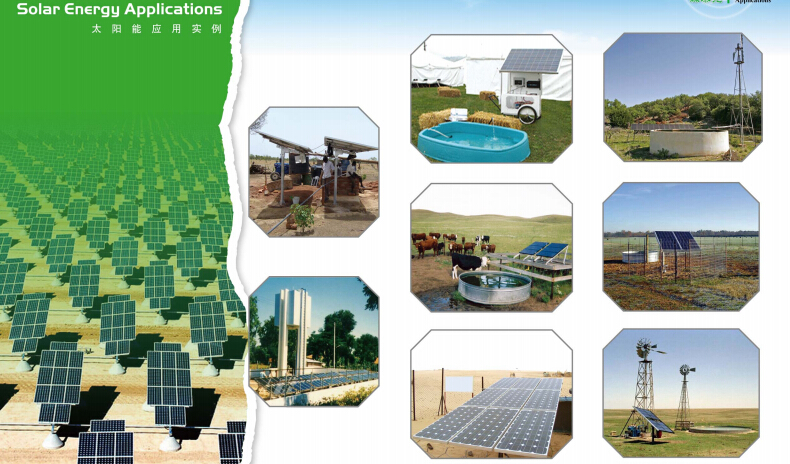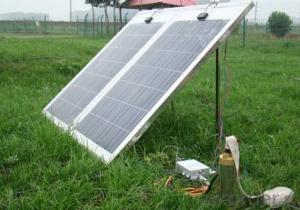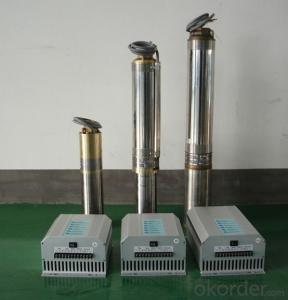Solar Pump for Water:0.1kw-37kw System Design / Helen
- Loading Port:
- Shanghai
- Payment Terms:
- TT OR LC
- Min Order Qty:
- 10 pc
- Supply Capability:
- 1000 pc/month
OKorder Service Pledge
OKorder Financial Service
You Might Also Like
The photovoltaic pumping system is different from the traditional AC pumping system , and the photovoltaic pumping system utilizes solar cells convert solar energy into electric energy , then the photovoltaic pumping inverter drives ac motor for the pump running , and pumping up water from water well , river , lake etc areas and then transport to the destination to satisfy our requests for the water demand .
Photovoltaic arrays adopts solar radiation energy to convert it to electric power ,providing the motive power for the whole system . And the function of the solar pumping inverter is converting the DC power output from PV array to AC power to drive the pump to finalize the water pumping up as well as adjusting the output power real-timely according to the change of sunlight intensity , in this way , the system realizes the max power point tracking and the solar energy can be utilized furthest
The whole system solves the water pumping up requests perfectly , omitting the battery bank and charge controller etc equipments , so it is very economical and environmental . Since they are with the merits of low carbon , energy conversation , environmental protection etc , so they have a broad market foreground and great social value


2.2 Application
Agricultural irrigation
Desert manage
Domestic water
Grassland animal husbandry
city waterscape
Island water supply
Landscape and fountain system of municipal engineering , city square , hotels and residence community
2.3 About product
This product is using a high performance digital signal processing chip, can provide solution for solar water pumpingsystem with high cost performance. Solar pumping system as a whole block diagram as shown in 2.
SHP series inverter has the following features:
a. True max power tracking technology (TMPPT) with our own intellectual property; effectively improve the use ratio of PV array. The stable tracking efficiency can reach 99.2% , Solving the problem of bad tracking efficiency and running unstability under the situation of sunlight intensity quick change when comparing with the traditional MPPT method .
b. Adopt efficient IPM power module from Mitsubishi Company with high reliability.
c. With the function of high and low water level detection , high safety factor.
d. Automatic anti-drying protection function , with multi-protection for motor
e. Multi-language LCD display , easy for operation , very user-friendly
f. The independent developed principal computer with our own intellectual properties , remote monitoring is available
g. Modular design , direct plug-in terminal , good-looking appearance, easy for installation , operation and maintenance .
h. Suitable for the pump adopted three phase asynchronous motor
i. Complete digital control , with the function of full automatic running and data storage .
j. Perfect protection system , with the protection function for lighting , over voltage , under voltage , short circuit , over loads , water drain off , low sunlight , over heating etc ,
k. Adopt the complete radiating system , so radiating efficiency is better and the service life is longer
l. Through strict environmental test , adapt the rigorous environment :-10℃~+50℃
m.No impacted mains supply power switch function (optional ), All-weather running available
n. Through strict environmental test , adapt the rigorous environment :-10℃~+50℃
1. How long will my inquiry get response?
Your inquiry related to our products or prices will be replied within 24 hours.
2. Can I get professional service and suggestion?
Well-trained and experienced staffs to answer all your questions in fluent English.
3. Do you accept OEM or customized design?
OEM & ODM, any your customized lightings we can help you to design and put into product.
4. What if I need specific design?
Distributorship are offered for your unique design and some our current models.




- Q: Do solar pumps require any additional equipment?
- Yes, solar pumps generally require additional equipment such as solar panels, a controller or inverter, and a storage tank or battery system for storing the generated energy.
- Q: Can a solar pump be used for water supply in off-grid homes or cabins?
- Yes, a solar pump can certainly be used for water supply in off-grid homes or cabins. Solar pumps use solar energy to power the pumping mechanism, eliminating the need for electricity from the grid. This makes them an ideal solution for remote locations where access to electricity is limited or non-existent. Solar pumps can be used to extract water from wells, boreholes, or other water sources and provide a reliable and sustainable water supply. They are cost-effective, environmentally friendly, and require minimal maintenance. Additionally, solar pumps can be combined with storage systems to ensure a constant water supply even during periods of low sunlight. Overall, using a solar pump for water supply in off-grid homes or cabins offers a practical and efficient solution that aligns with sustainable and self-sufficient living.
- Q: Can solar pumps be used for water supply in agricultural cooperatives or farming communities?
- Yes, solar pumps can be effectively used for water supply in agricultural cooperatives or farming communities. Solar pumps are a sustainable and cost-effective solution as they utilize solar energy to power the pumps, eliminating the need for electricity or fossil fuels. They can provide a reliable source of water for irrigation, livestock, and other agricultural needs, helping to improve crop yields and overall productivity in these communities. Additionally, solar pumps require minimal maintenance and have a long lifespan, making them suitable for remote and off-grid areas.
- Q: Can a solar pump be used for water supply in off-grid fish farms?
- Yes, a solar pump can be used for water supply in off-grid fish farms. Solar pumps are an excellent and sustainable solution for providing water to fish farms located in remote areas where grid electricity is not available. These pumps are powered by solar energy, meaning they do not require any external power source or fuel, making them cost-effective and environmentally friendly. Solar pumps can be used to extract water from a water source such as a river, lake, or borehole, and deliver it to the fish ponds or tanks. They can be designed to provide a constant flow of water, ensuring that the fish have an adequate supply for their growth and well-being. The use of solar pumps in off-grid fish farms offers several advantages. Firstly, it reduces the dependence on fossil fuels and grid electricity, which can be expensive and unreliable in remote locations. Solar pumps are powered by sunlight, which is renewable and abundant, making it a sustainable solution for long-term water supply. Additionally, solar pumps require minimal maintenance as they have fewer moving parts compared to traditional pumps. This reduces the risk of mechanical failures and the need for frequent repairs, resulting in lower operational costs and increased efficiency. Moreover, solar pumps can be easily integrated into existing fish farm infrastructure without significant modifications. They are available in various sizes and capacities, allowing for customization based on the specific water requirements of the fish farm. In conclusion, a solar pump can indeed be used for water supply in off-grid fish farms. It provides a reliable, cost-effective, and environmentally friendly solution for ensuring a continuous and sustainable water supply to support the growth and health of fish in remote locations.
- Q: Are solar pumps suitable for use in developing countries with limited access to electricity?
- Yes, solar pumps are suitable for use in developing countries with limited access to electricity. Solar pumps provide a sustainable and reliable source of power for water pumping, which is essential for agricultural and domestic purposes in these countries. They eliminate the need for grid electricity or expensive fuel-powered pumps, making them cost-effective and environmentally friendly. Additionally, solar pumps require minimal maintenance and are easy to operate, making them suitable for use in remote areas with limited technical expertise.
- Q: What is the typical lifespan of the motor used in a solar pump?
- The typical lifespan of a motor used in a solar pump can vary depending on various factors such as the quality of the motor, maintenance practices, and operating conditions. However, on average, a well-maintained and high-quality motor used in a solar pump can last anywhere between 10 to 20 years.
- Q: How does a solar pump compare to a traditional electric pump in terms of efficiency?
- A solar pump is generally more efficient than a traditional electric pump. Solar pumps use energy from the sun to power the pump, eliminating the need for electricity from the grid. This results in lower operating costs and a reduced carbon footprint. Additionally, solar pumps are often designed with advanced technology that maximizes efficiency and optimizes water flow. However, it is important to consider factors such as the size of the pump, location, and specific application requirements to determine the most efficient option for a particular situation.
- Q: What is the payback period for a solar pump installation?
- The payback period for a solar pump installation depends on various factors such as the initial cost of installation, the amount of energy saved, and any applicable incentives or subsidies. On average, the payback period for a solar pump installation ranges from 3 to 7 years. However, it is important to conduct a detailed analysis considering the specific circumstances and costs involved to accurately determine the payback period.
- Q: Can a solar pump be used for water treatment in developing countries?
- Yes, a solar pump can be used for water treatment in developing countries. Solar pumps are a sustainable and cost-effective solution for providing clean and safe water in areas with limited access to electricity. They can power water treatment systems, such as filtration or disinfection units, ensuring that the water is free from contaminants and suitable for consumption. Solar pumps also eliminate the need for fossil fuels, reducing environmental impact and making them an ideal choice for water treatment in developing countries.
- Q: Can a solar pump be used for water supply in remote holiday resorts?
- Yes, a solar pump can be used for water supply in remote holiday resorts. Solar pumps are powered by sunlight, making them ideal for off-grid locations. They can efficiently draw water from wells, rivers, or other sources and provide a reliable water supply for various purposes in remote areas, including holiday resorts. Additionally, solar pumps are environmentally friendly and cost-effective, making them a sustainable solution for water supply in remote locations.
Send your message to us
Solar Pump for Water:0.1kw-37kw System Design / Helen
- Loading Port:
- Shanghai
- Payment Terms:
- TT OR LC
- Min Order Qty:
- 10 pc
- Supply Capability:
- 1000 pc/month
OKorder Service Pledge
OKorder Financial Service
Similar products
Hot products
Hot Searches
Related keywords



























